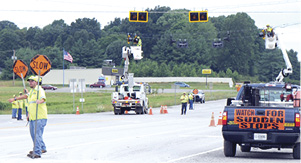State says ‘no’ to request for traffic signal at 127/90/734

Saying he was disappointed with a recent development concerning work to have traffic signals installed at the county’s most dangerous and complicated highway intersection, Clinton County Judge/Executive Richard Armstrong also said he was in no way ready to give up.
The project in question is at the intersection of U.S. 127, Ky. 90 and Hwy. 734 in the Snow Community, near the Junction Station and Restaurant.
That location has been the site of several traffic accidents over the past several years, many of which were severe multi-vehicle accidents and many of which have resulted in fatalities and a host of serious injuries.
Armstrong recently received correspondence from Tamra Wilson, the District 8 Acting Chief District Engineer, indicating that after a study had been completed by the Kentucky Department of Transportation, it was the conclusion that traffic signals would not be installed.
Currently there are flashing caution lights at the intersection and Armstrong and other county officials, as well as private citizens, have been working to have those flashing caution lights replaced with actual traffic signals with the traditional green and red, “go and stop” type of signal.
Armstrong provided the Clinton County News with a copy of the letter he received at the end of June from Wilson, with the news that after the study, the intersection did not warrant the installation of traffic signals.
Although several factors were listed by Wilson in the letter regarding the decision to not honor the request for the traffic signals, her letter made an initial reference to the traffic volume at the intersection.
Wilson states in her letter that a review of the intersection had been completed and a host of data had been collected and compiled, including analyzing traffic volumes, accident history, critical rate factors and other information, including information that had been submitted by Armstrong’s office when he made the request.
“According to the date collected, it appears that traffic volumes are below the criteria needed to satisfy traffic signal warrants normally considered for signalization,” Wilson said.
Her letter of explanation also noted that special tube counts were conducted in the area of the intersection – a method used by the agency to count the volume of traffic – and she added that among those counts were special counts that would be used to analyze the impact of summertime tourist traffic in comparison to normal daily traffic.
However, that study would not have included the busiest summer tourism holiday of the year for Albany and Clinton County, the recent July 4 holiday.
The Clinton County News spoke via telephone to Amber Hale, the Information Officer for the District 8 office in Somerset about the letter from Wilson.
In a follow-up email, Hale explained that the special tube count dates that were used to count traffic volume at the intersection was conducted during the week of June 10-17.
“The tube counts are those that are conducted with the traffic counters that are placed across the roadway which count the vehicles as they drive over them,” Hale said. “The numbers from this count were compared with the last manual hand count that was conducted for a 12 hour period in September 2015.”
She further explained that it was that September count that was used as the summertime count, noting that there had not been enough difference in the counts to meet the warrants required for installing traffic signals.
As to the number of traffic accidents at the intersection, Wilson said that the installation of traffic signals likely wouldn’t reduce the number of accidents at the location
“A review of the most recent three year crash history, however, revealed that this intersection did not appear to exhibit a pattern of crashes that could be susceptible to correction through the installation of a traffic signal,”Wilson said.
Both Wilson and Hale also noted that the data base used to gather information concerning traffic accidents at the intersection, couldn’t completely be counted due to many of the accident reports never having been finalized by law enforcement officers working accidents there.
Hale explained that the CRASH data base used in investigations such as this, have a number of crashes that have been left in “Draft” mode by law enforcement officers working accidents there, and until those reports are closed out from the “Draft” mode into a “Final” standing, any information about that particular accident is not available to the Transportation Department.
Wilson later added that the possibility exists that traffic signals could even make the number of accidents increase.
“Traffic control signals are often considered a cure-all for all traffic problems at intersections,” Wilson said. “However, unwarranted signals can result in an increase in crash rates and delays.”
She added that because of the rural location, a traffic signal would not be expected by motorists traveling on Ky. 90, and could actually result in more severe side impact crashes.
“It is important to emphasize that a traffic signal does no guarantee safety,” Wilson said. “It merely assigns right-of-way to motorists.”
Hale also said that oftentimes they see that any change in traffic patterns, including the installation of traffic signals, will cause an increase in accidents, giving for example the rash of accidents that occurred along the Albany Bypass at intersections when construction of that roadway was completed and right-of-ways directions were changed.
Armstrong told the Clinton County News Monday morning, however, that he was in no way ready to give up on the project of being successful in getting traffic signals installed at the intersection.
The Judge/Executive further noted that he had already taken the matter to Frankfort and had been in discussions with Gary Lee, the Deputy Commissioner of Kentucky Transportation.
“I want the people of Clinton County to know just how much time I’ve put into this – I’ve been working on this for 18 months,”Armstrong said. “A lot of effort has gone into this, and I’m still working on it.”
In her letter, Wilson did say that the Department of Transportation would add some visible enhancements to the flashing beacons already in place at the intersection with the addition of “retro-reflective backplates” as well as additional reflective tape on the top of the stop sign posts at the intersection.
That work was completed by the District 8 crew members last week, and while Armstrong said he had not yet viewed those improvements after the work had been completed, he would still continue to work toward what he feels will be a safer alternative for all motorist traveling through the intersection, the installation of a traffic signal light.
“I can’t go down there and make them put one up – believe me, if I could, I would,” Armstrong said.
A construction crew with the Kentucky Department of Transportation was busy directing traffic and installing enhanced reflector surrounds on the flashing caution beacons that were already in place at the intersection of U.S. 127, KY 90 and Hwy. 734 in the Snow Community of Clinton County.
After requests from the Clinton County Fiscal Court and Judge/Executive Richard Armstrong, as well as a petition campaign from a private citizen group, the agency has said that the installation of a traffic signal, commonly referred to as a “stop light”, was “not warranted” at this time. The intersection has been the scene of several serious traffic accidents over the years.



